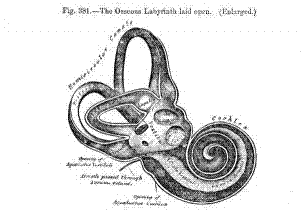
Medical illustration of the human osscous labyrinth, from "1870 Gray's Anatomy Descriptive And Surgical Book - First Edition". (Credit: iStockphoto/Mark Strozier)
ScienceDaily (Oct. 23, 2009) — Deep in the ear, 95 percent of the cells that shuttle sound to the brain are big, boisterous neurons that, to date, have explained most of what scientists know about how hearing works. Whether a rare, whisper-small second set of cells also carry signals from the inner ear to the brain and have a real role in processing sound has been a matter of debate.
Now, reporting on rat experiments in the October 22 issue of Nature, a Johns Hopkins team says it has for what is believed to be the first time managed to measure and record the elusive electrical activity of the type II neurons in the snail-shell-like structure called the cochlea. And it turns out the cells do indeed carry signals from the ear to the brain, and the sounds they likely respond to would need to be loud, such as sirens or alarms that might be even be described as painful or traumatic.
To view the entire article, please click on the link above.
No comments:
Post a Comment